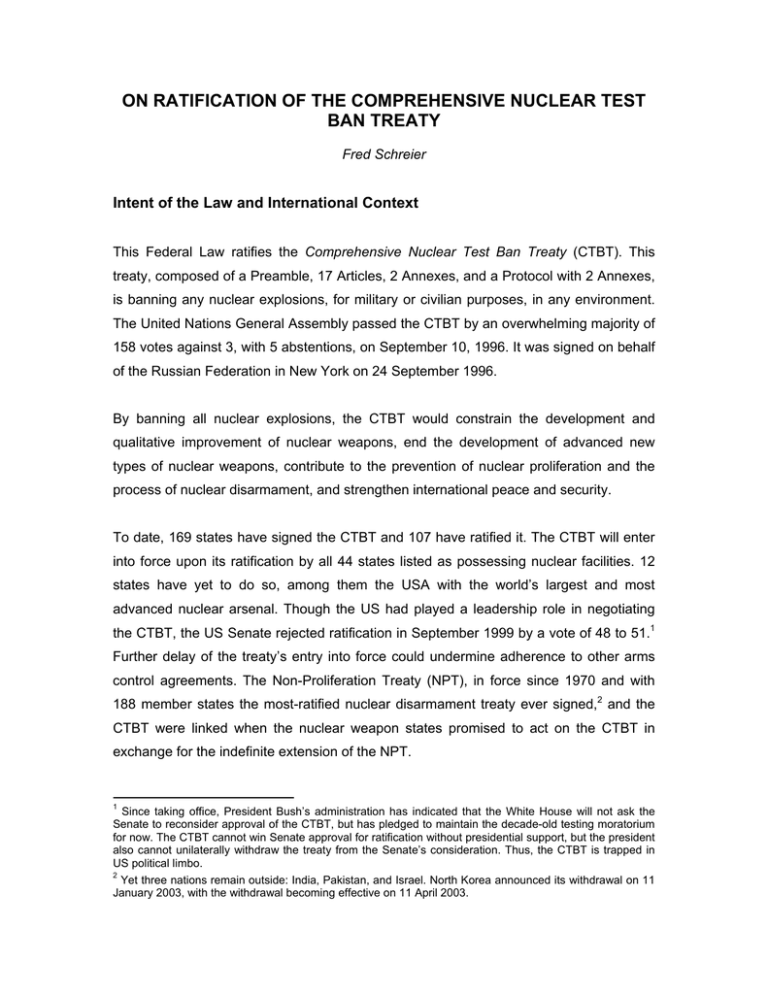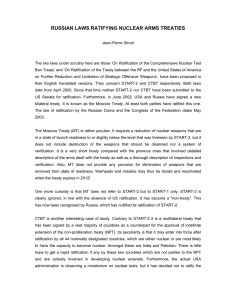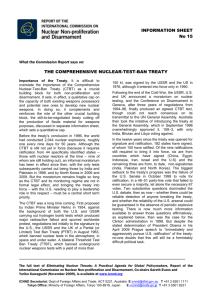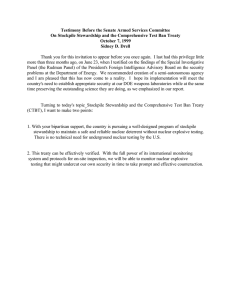ON RATIFICATION OF THE COMPREHENSIVE NUCLEAR TEST BAN TREATY
advertisement

ON RATIFICATION OF THE COMPREHENSIVE NUCLEAR TEST BAN TREATY Fred Schreier Intent of the Law and International Context This Federal Law ratifies the Comprehensive Nuclear Test Ban Treaty (CTBT). This treaty, composed of a Preamble, 17 Articles, 2 Annexes, and a Protocol with 2 Annexes, is banning any nuclear explosions, for military or civilian purposes, in any environment. The United Nations General Assembly passed the CTBT by an overwhelming majority of 158 votes against 3, with 5 abstentions, on September 10, 1996. It was signed on behalf of the Russian Federation in New York on 24 September 1996. By banning all nuclear explosions, the CTBT would constrain the development and qualitative improvement of nuclear weapons, end the development of advanced new types of nuclear weapons, contribute to the prevention of nuclear proliferation and the process of nuclear disarmament, and strengthen international peace and security. To date, 169 states have signed the CTBT and 107 have ratified it. The CTBT will enter into force upon its ratification by all 44 states listed as possessing nuclear facilities. 12 states have yet to do so, among them the USA with the world’s largest and most advanced nuclear arsenal. Though the US had played a leadership role in negotiating the CTBT, the US Senate rejected ratification in September 1999 by a vote of 48 to 51.1 Further delay of the treaty’s entry into force could undermine adherence to other arms control agreements. The Non-Proliferation Treaty (NPT), in force since 1970 and with 188 member states the most-ratified nuclear disarmament treaty ever signed,2 and the CTBT were linked when the nuclear weapon states promised to act on the CTBT in exchange for the indefinite extension of the NPT. 1 Since taking office, President Bush’s administration has indicated that the White House will not ask the Senate to reconsider approval of the CTBT, but has pledged to maintain the decade-old testing moratorium for now. The CTBT cannot win Senate approval for ratification without presidential support, but the president also cannot unilaterally withdraw the treaty from the Senate’s consideration. Thus, the CTBT is trapped in US political limbo. 2 Yet three nations remain outside: India, Pakistan, and Israel. North Korea announced its withdrawal on 11 January 2003, with the withdrawal becoming effective on 11 April 2003. Until the CTBT comes into effect, the members of the nuclear club are observing a moratorium on testing. If the US breaches the moratorium, the Russian Federation will do the same. Russia might also withdraw from the CTBT if it felt its national security interests were threatened. More than that, Russia’s new military doctrine states that it might be the first to use nuclear weapons if there is no other way to protect its security. The CTBT established an organization to ensure implementation, which includes a Conference of States Parties, an Executive Council, and a Technical Secretariat. The treaty’s extensive verification regime includes an International Monitoring System, an International Data Center which is part of the Technical Secretariat, On-Site Inspections, and Confidence Building Measures. The International Monitoring System comprises a network of 321 monitoring stations and 16 radionuclide laboratories that monitor the earth for evidence of nuclear explosions in all environments. Seismic, hydro-acoustic, and infrasound stations are employed to monitor the underground, underwater, and atmosphere. Radionuclide stations can detect radioactive debris from atmospheric explosions or vented by underground or underwater nuclear explosions. The four technologies were selected for their technical and cost effectiveness and the synergy between them. More than 55 percent of the monitoring stations are now operational. The data generated by the monitoring technologies are transmitted via a global communication system to the International Data Center in Vienna, Austria. The data is then combined and made available to the signatories to the CTBT. Under the treaty’s global verification regime of 321 monitoring stations, the Russian Federation has concluded a Facility Agreement with the Preparatory Commission (PrepCom)3 of the Comprehensive Test Ban Treaty Organization to deploy on its territory 6 primary seismic stations, 13 auxiliary seismic stations, 8 radionuclide stations, 1 radionuclide laboratory, and 4 infrasound stations.4 All facilities are being deployed within the Comprehensive Test Ban Treaty Organization’s International Monitoring System and International Data Center network. Moreover, the Russian Federation will 3 4 Established on 19 November 1996 in order to bridge the period until the CTBT’s entry into force. For details and locations see: http://www.ctbto.org/verification/facilities/monfacoutput.dhtml?&state=143 retain a national capability to allow her to reach an independent judgment on the data produced by the International Monitoring System.5 Enactment and scope of the Federal Law on Ratification of the CTBT Adopted by the State Duma (by 298 votes to 44) on 21 April 2000, approved by the Council of Federation on 17 May 2000, and signed by the President of the Russian Federation in Moscow on 27 May 2000, this Federal Law on Ratification of the CTBT completed the process of ratification. When the Russian Federation deposited its instrument of ratification with the General-Secretary of the United Nations6 in May 2000, it became the 30th member state to accede the CTBT. The Law itself is a general framework law, containing a summary of the purposes of the law, and 8 Articles. The Contents of the Law Article 1 asserts the ratification of the CTBT. Article 2 specifies in 7 paragraphs the terms on which the Treaty will be implemented, pertaining to the maintenance of operational availability, reliability and security of the nuclear arsenal of the Russian Federation; support of the nuclear arms complex, and its modernization; development of nuclear arms technologies; maintenance of a potential for possible re-activation of nuclear test activity; perfection of control over foreign nuclear testing; reconnaissance of and data collection on foreign nuclear arsenals and weapons developments; and priority financing of these activities as well as measures associated with the implementation of the CTBT. 5 Russian Defence Minister Igor Sergeyev proposed in November 2001 that Russia might consider “additional verification measures for nuclear test ranges going far beyond the treaty provisions”, but only after the CTBT enters into force. 6 United Nations, General Assembly. Fifty-Fifth session. 23 May 2000; Document A/55/79. See also: Secretary-General deeply gratified by Russian Federation’s ratification of the nuclear-test-ban treaty. United Nations Press Release SG/SM/7366, 24 April 2000. Article 3 describes in 3 paragraphs the responsibilities of the President, the Government, and of the Chambers of the Federal Assembly of the Russian Federation. In the case of the President, these responsibilities pertain to the governing of activities in support and maintenance of the nuclear arsenal, reliability and security of nuclear weapons; State guidance of activities, weapons and test programs; and decisions associated with the implementation of the CTBT. In case of the Government, these responsibilities pertain to the management and development of directives and programs decided by the President; measures to perfect control over foreign nuclear tests; definition of functions and executive authorities for the interaction with organizational bodies of, and Russian compliance with, the CTBT; decisions, and conclusion of agreements with authorized bodies, on the creation and functioning of the international monitoring system in the Russian Federation; appointing and instituting the national body of the CTBT; submitting an annual report to the President on reproduction of nuclear weapons without full-scale nuclear tests; financing the Russian dues to the budget of the CTBT Organization; and, upon commission of the President, exercising foreign policy measures required for the implementation of the CTBT. As to the responsibilities of the Chambers of the Federal Assembly: these have to take part in decision-making, and elaborate and adopt laws, on the funding and other measures required for the implementation of the treaty; they have to consider the annual information of the Government forwarded in compliance with the following Article 5 of this law and take appropriate decisions; and, if extraordinary events related to the subject matter of the CTBT jeopardize Russian supreme interests, they will have to take measures envisaged in Section V of the Federal Law on the International Treaties of the Russian Federation, in case Russia may contemplate withdrawal from the CTBT. Article 4 asserts that the Preparatory Commission, its personnel, and the delegates of the States, will enjoy the legal capacity, and such privileges and immunities as are necessary, for the exercise of their functions in the territory of the Russian Federation prior to the enforcement of the treaty. Article 5 specifies 5 items of information, covering activities, progress, and compliance of all parties with the treaty, the Government is mandated to report to the Chambers of the Federal Assembly one year after enforcement of the CTBT, and from then on annually. Article 6 specifies in 2 paragraphs the terms on which the Russian Federation may withdraw from the treaty, the measures to be taken in such case, and the consultations and procedures to be followed in compliance with the Federal Law on the International Treaties of the Russian Federation. Article 7 stipulates that in case of withdrawal of the Russian Federation from the CTBT, nuclear tests will be implemented upon sanction by the President. Article 8 provides for the Federal Law on Ratification being in force from the date of its official publication. Commentary Overall, the Federal Law on Ratification of the CTBT is a succinct and comprehensive document. Since it has been accepted by the Secretary-General of the UN and the UN General Assembly as a main instrument of ratification, it served the purpose well. In view of the fact that it is framework law of a rather wide compass, the text is inevitably kept rather general in nature. In scope, it ranges over clearly defined policy areas pertaining to the President, the Government and to the Legislature. The definitions of responsibilities contained in Article 3 seem to establish sufficient room and flexibility for the regulation of all necessary details7 ─ either by decrees and directives of the President or by acts and directives of the Government ─ to make the adoption of an 7 Such as: Empowerment of the Ministry, that will assume the role of National Authority, serve as national focal point for liaison with the CTBT Organization and with other State Parties, ensure the implementation of the treaty’s provision, including those for international verification of compliance with the CTBT. Selecting the Offices, Institutions or Organizations taking part in the International Monitoring System and responsible for the seismological, infrasound, radionuclide stations, and the radionuclide laboratory. Appointment of the Office or Organization which will assume the role of the National Data Centre and which is responsible for transmitting the technical data from the Russian Stations to the International Data Centre. Designation of the Organizations responsible for the engagement of national technical means. Regulating the request for and disclosure of information, on-site inspections and privileges and immunities concerning the inspections, etc. supplementary Law on the Implementation of the CTBT existing in other states8 unnecessary prior to the day of entry into force of the CTBT. However, if in the practice of the application of the CTBT it would appear that, for encompassing all aspects needed for compliance with the treaty, such a supplementary law would be preferable to the collection of too numerous decrees, acts, and directives, there is still the possibility to use the mandated reporting of the Government to the Chambers of the Federal Assembly one year after enforcement of the CTBT, or annually thereupon, to decide on, and to enact, a Law on the Implementation of the CTBT. 8 See for example Canada at: http://laws.justice.gc/en/C-36.5/35234.html, or the Nuclear Explosions (Prohibition and Inspections) Act 1998 of the UK at: http://www.hmso.gov.uk/acts1998/1998007.htm, the German implementing law adopted in 1998, or the equivalent Australian act.


